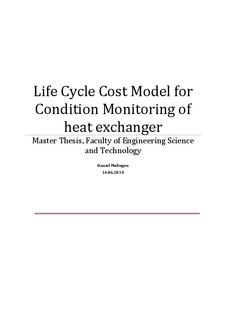| dc.description.abstract | Shell and tube heat exchangers (H/X) are widely used in the industry. Offshore, the H/Xs are used as heaters or coolers. In this thesis it is assumed that the H/X function is to cool down gas or oil. A large number of different configuration of H/X exist today, single pass and u-bend is most used offshore. This thesis looks further into the most used H/X on an offshore platform single pass.
The thesis is dealing with formulas that indicate performance of an H/X. It is normal to have the ability to measure parameter as pressure, temperature and mass flow. With these parameters the efficiency of the heat exchanger can be calculated. In order to use the efficiency the reference efficiency, from when the H/X was new must be present. It is also possible to measure the performance over time. Calculations of efficiency give an indication of failure. However, it gives limited information what failure modes occurred.
There are present three different maintenance strategies, fixed time, fixed age and condition monitoring. Fixed time and fixed age is beneficial to use on critical items, and when condition monitoring (CM) has low probability to find failures or is impossible to use. If the failure is developing fast fixed time and fixed age could be beneficial to use. CM should give a good indication on the condition of the different items. This makes it easier to plan when a maintenance action should be carried out.
Six different CM methods are present in the thesis and used as a basis of the analysis. The different methods are Ultrasonic testing (UT), Eddy Current Testing (ECT), Visual inspection (VI), Magnetic Particle inspection (MPI) and HXAM-ST. These are methods which are widely used on H/Xs.
Failure modes and maintenance items used in the thesis are collected from source OREDA (1). The maintainable items are present in a block diagram. Fault tree analysis and Failure Mode and Effect (FMEA) analysis, shows that the most common failure cause is corrosion, erosion and external forces. The FMEA connects the failure modes with the CM methods.
Probability to detect failures with the different failure modes are based on assumption with values from 0-1. The methods have different characteristics and the probability to find failures are based on these characteristics. ECT is specially classified on finding failures in the tube bundle. VI is a more general method who is able to find failure over a wide range. MPI is a method used on shell while the H/X is in operation. HXAM-ST is a method on development stage and it monitors the H/X performance as pressure, temperature and mass flow.
The Life Cycle Cost (LCC) analysis is based on the report (2), and has been modified from a LCC for an item to a LCC regarding CM methods. To identify the different cost elements a cost break down structure is made. The CBS is decomposed into capital expenditure (CAPEX) and operation expenditure (OPEX). Pareto diagram is made to show the three largest costs regarding OPEX. On five of the methods personnel cost is the significant highest cost. On HXAM-ST that does not need personnel, documentation is the highest operational cost.
Benefits are calculated from less down time, less injuries and less death due to failure. In spite of this, factored benefits are taken into consideration. Factored benefit is based on issues as operation safety, personnel safety, technical fitness for purpose and operational issues.
A cost benefit model is made where both LCC and benefits from performing the CM method are taken into consideration. The model shows that UT is the most cost effective method, and MPI is the only method that has larger costs than benefits. HXAM-ST is a Non Intrusive method, and gives the ability to introduce Condition Based Maintenance (CBM).
Redundancy is the input parameter which has the largest impact on the model. The largest benefit with the methods is less downtime due to detection of the failure. If redundancy is present this benefit would disappear, since almost no downtime would appear. Changes in the operational condition like more sand or a more corrective environment would also have a large impact on the failure rate for the different failure modes.
The main outcome from sensitivity analysis is that method as: VI, HXAM-ST and HLT with low LCC cost scores when the benefits are decreasing and the more expensive methods as UT and ECT scores when the benefits is increasing, in spite of high probability to detect failures. | nb_NO |
